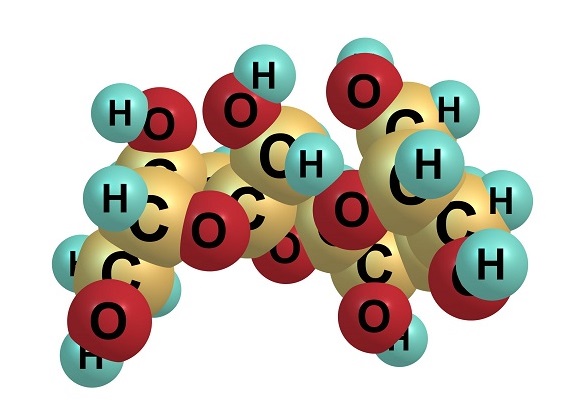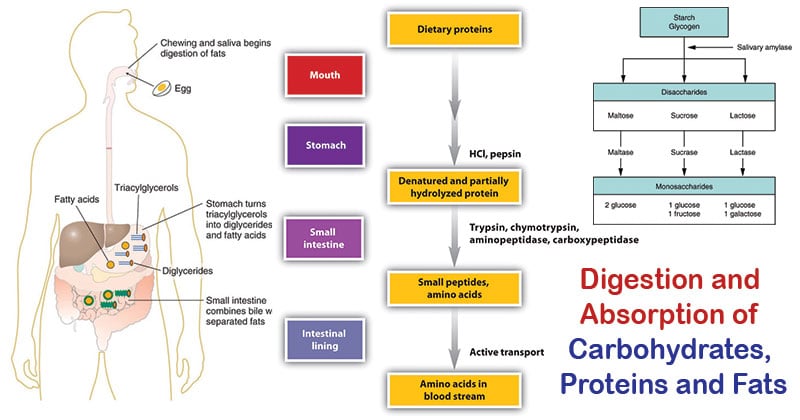Carbohydrates and the glycaemic index

Foods and drinks provide our body with energy in the form of carbohydrates, fat, protein and alcohol. Carbohydrates are the body’s preferred energy source. The glycaemic index (GI) is a way that carbohydrates in foods and drinks are ranked according to how quickly they raise the glucose level of the blood (also known as ‘blood sugar level’). It has replaced classifying carbohydrates as either ‘simple’ or ‘complex’.
Foods with carbohydrates include bread, breakfast cereals, rice, pasta, legumes, corn, potato, fruit, milk, yoghurt, sugar, biscuits, cakes and lollies.

Digesting and absorbing carbohydrates

The digestive system breaks down carbohydrates in foods and drinks into simple sugars, mainly glucose. For example, both rice and soft drink will be broken down to simple sugars in your digestive system. This simple sugar is then carried to your body’s cells through the bloodstream.
The pancreas secretes a hormone called insulin, which helps the glucose to move from your blood into the cells. Once inside a cell, the glucose is ‘burned’ along with oxygen to produce energy. Our brain, muscles and nervous system all rely on glucose as their main fuel to make energy.
The body converts excess glucose from food into glycogen. Glycogen acts as a storage form of glucose within the muscle tissue and the liver. Its role is to supplement blood glucose levels if they drop between meals (especially overnight) or during physical activity.
The glycaemic index (GI)

The glycaemic index (GI) is a way of ranking carbohydrate-containing foods based on how slowly or quickly they are digested and increase blood glucose levels over a period of time – usually two hours.
The GI uses glucose or white bread as a reference food – it has a GI score of 100. Carbohydrate-containing foods are then compared with this reference to assign their GI. This ensures all foods compared have the same amount of carbohydrate, gram for gram.
Carbohydrates that break down quickly during digestion have a higher glycaemic index. These high GI carbohydrates, such as a baked potato, release their glucose into the blood quickly.
Carbohydrates that break down slowly, such as oats, release glucose gradually into the bloodstream. They have low glycaemic indexes. The blood glucose response is slower and flatter. Low GI foods prolong digestion due to their slow breakdown and may help with feeling full.
GI scale examples
The terms ‘low GI’, ‘medium GI’ and ‘high GI’ are given to foods that fall within different ranges of the GI.
These ranges, along with some example foods, include:
- low GI (less than 55) – examples include soy products, beans, fruit, milk, pasta, grainy bread, porridge (oats) and lentils
- medium GI (55 to 70) – examples include orange juice, honey, basmati rice and wholemeal bread
- high GI (greater than 70) – examples include potatoes, white bread and short-grain rice.
Factors that affect the GI of a food
Factors such as the size, texture, viscosity (internal friction or ‘thickness’) and ripeness of a food affect its GI. For instance, although both ripe and unripe bananas have a low GI (less than 55), an unripe banana may have a GI of 30, while a ripe banana has a GI of 51.
Fat, protein, soluble fibre, fructose (a carbohydrate found in fruit and honey) and lactose (the carbohydrate in milk) also generally lower a food’s glycaemic response. Fat and acid foods (like vinegar, lemon juice or acidic fruit) slow the rate at which the stomach empties and slow the rate of digestion, resulting in a lower GI.
Other factors present in food, such as phytates (used to store phosphorus in plants) in wholegrain breads and cereals, may also delay a food’s absorption and lower the GI.
Cooking and processing can also affect the GI – food that is broken down into fine or smaller particles will be more easily absorbed and so has a higher GI. Foods that have been cooked and allowed to cool (potatoes, for example) can have a lower GI when eaten cold than when hot (for example, potato salad compared with hot baked potato).
High GI foods are influenced by low GI foods
Generally, eating low GI foods and high GI foods at the same time has the effect of ‘averaging’ the GI. This is important, as most foods are eaten as part of a meal and this affects the GI value of foods. For example, eating cornflakes (a higher GI food) with milk (a lower GI food) will reduce the overall effect of the cornflakes and milk meal on blood glucose levels.
GI symbol and claims on packaged foods
You might have noticed that some packaged food products have a GI symbol or make claims about the food’s GI and its health effects (for example, ‘low GI to help you stay fuller for longer’). These are examples of nutrition content claims and general level health claims, allowed by Food Standards Australia New Zealand under Standard 1.2.7 Nutrition, health and related claims.
The Low GI Symbol and claims about the relationship of a low GI product and its effect on health is only available to packaged food products that meet strict nutritional and testing criteria.
This labelling is not compulsory for food companies to follow, so not all products that are eligible will display the symbol or make a claim. This is often the case for smaller companies who may not have the money to go through the necessary processes to be given the label. These claims also won’t generally be used on food products that would be eligible but are not typically packaged (for example, fresh fruit and vegetables).
Glycaemic Load (GL)
The amount of the carbohydrate-containing food you eat affects your blood glucose levels. For example, even though pasta has a low GI, a large serving can still cause the blood glucose levels to rise more rapidly than a smaller serving. This is what is called the glycaemic load (GL).
The GL builds on GI, as it considers both the GI of the food and the amount of carbohydrate in a portion. GL is based on the idea that a high GI food consumed in small quantities would give the same effect on blood glucose levels as larger quantities of a low GI food.
GL can be calculated easily if you know what the food’s GI is and how much carbohydrate is present in the serving.
Calculating Glycaemic Load (GL)
The GL calculation is: GI x the amount of carbohydrates (in grams) in a serving of food) ÷ 100.
Using a pasta example:
- GI of a standard white wheat pasta, boiled to al dente texture = 43
- The carbohydrate content of a standard 180g serve = 44g
- GL = 43 x 44/100 = 19g
However, if a half portion of pasta was eaten, the GL would also halve:
- GI of a standard white wheat pasta, boiled to al dente texture = 43
- The carbohydrate content of a half portion 90g serve = 22g
- GL = 43 x 22/100 = 9.5g
Here is another example, where both foods contain the same amount of carbohydrate but their GIs are different:
- A small baked potato (GI = 80, carbohydrate = 15g)
- GL = 80 x 15/100 = 12g
- An apple (GI = 40, carbohydrate = 15g)
- GL = 40 x 15/100 = 6g
Both the small baked potato and the apple have the same amount of carbohydrate (15g). However, because their GIs differ (the apple is low while the baked potato is high), their GLs also differ, which means the baked potato will cause the blood glucose level of the person eating it to rise more quickly than the apple.
The University of Sydney’s GI search shows the GI, GL and carbohydrate content per serving of a wide variety of foods.
GI and exercise

Eating low GI foods two hours before endurance events, such as long-distance running, may improve exercise capacity. It’s thought that the meal will have left your stomach before you start the event, but remains in your small intestine releasing energy for a few hours afterwards.
Moderate to high GI foods may be most beneficial during the first 24 hours of recovery after an event to rapidly replenish muscle fuel stores (glycogen).
Using the GI as a guide to healthy eating

The GI can be considered when choosing foods and drinks consistent with the Australian Guide to Healthy Eating, but there are limitations. For example, the GI of some everyday foods such as fruits, vegetables and cereals can be higher than foods to be eaten occasionally (discretionary) like biscuits and cakes. This does not mean we should replace fruit, vegetables and cereals with discretionary choices, because the first are rich in important nutrients and antioxidants and the discretionary foods are not.
GI can be a useful concept in making good food substitution choices, such as having oats instead of cornflakes, or eating grainy bread instead of white bread. Usually, choosing the wholegrain or higher fibre option will also mean you are choosing the lower GI option.
It’s not always possible or necessary to choose all low GI foods. There is room in a healthy diet for moderate to high GI foods, and many of these foods can provide important sources of nutrients. Remember, by combining a low GI food with a high GI food, you will get an intermediate GI for that meal.
Choosing between high and low GI foods
The best carbohydrate food to eat varies depending on the person and situation. For example, people with type 2 diabetes or impaired glucose tolerance have become resistant to the action of insulin or cannot produce insulin rapidly enough to match the release of glucose into the blood after eating carbohydrate-containing foods. This means their blood glucose levels may rise above the level considered optimal.
Now consider two common breakfast foods – cornflakes and porridge made from wholegrain oats. The rate at which porridge and cornflakes are broken down to glucose is different. Porridge is digested to simple sugars much more slowly than cornflakes, so the body has a chance to respond with production of insulin, and the rise in blood glucose levels is less.
For this reason, porridge is a better choice of breakfast cereal than cornflakes for people with type 2 diabetes. It will also provide more sustained energy for people without diabetes.
On the other hand, high GI foods can be beneficial at replenishing glycogen in the muscles after strenuous exercise. High GI can also quickly restore blood glucose levels to normal when someone with diabetes is experiencing a ‘hypo’, which is when their blood glucose levels fall below the normal range of 4–8 mmol/L. For example, eating five jellybeans will help to raise blood glucose levels quickly. A person with diabetes is only at risk of a ‘hypo’ if taking certain medications or injecting insulin.
If you have a medical condition, such as diabetes, it’s important to get advice from your doctor or specialist before making any changes to your diet.






